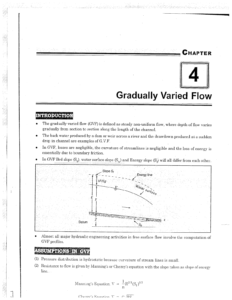
IES MASTER GATE MATERIAL
OPEN CHANNEL FLOW
GATE – PSU – IES – GOVT EXAMS – STUDY MATERIAL
FREE DOWNLOAD PDF


CONTENTS :
- INTRODUCTION
- UNIFORM FLOW
- ENERGY DEPTH RELATIONSHIP
- GRADUALLY VARIED FLOW
- RAPIDLY VARIED FLOW – HYDRAULIC FLOW
- UNSTEADY FLOW – SURGE
INTRODUCTION TO OPEN CHANNEL FLOW :
OPEN CHANNEL FLOW
INTRODUCTION :
-
An open channel is a natural or a man made structure in which liquid flows with a free surface at atmospheric pressure.
-
For example, flow in rivers, streams, flow in sanitary and storm sewers flowing partially full.
TYPES OF CHANNEL

Prismatic and Non-Prismatic Channels
-
A channel in which the cross sectional shape, size and the bed slope are constant is termed as Prismatic channel.
-
All natural channels generally have varying cross section and consequently are known as Non-prismatic channels.
-
Most of the man made channel are prismatic channels over long stretches. Rectangle, trapezoid, triangle and circle are commonly used shapes in man made channels.
-
Rigid and Mobile Boundary Channels Rigid channels are those in which the boundary is not deformable.
-
The shape and roughness factor is not a function of flow parameter. In other words, in Rigid channels, the flow velocity and shear stress distribution will be such that no major scouring, erosion or deposition will take place in the channel and the channel geometry and roughness are essentially constant with respect to time.
-
For example, lined canals and non-erodible unlined canals In Rigid channels only depth of flow may vary with space and time depending on the nature of flow.
-
Hence these channels have one(1) degree of freedom.
-
Mobile channels are those in which the boundaries undergo deformation due to the continuous process
-
In mobile channels, the resistance to flow, quantity of sediment transported and channel geometry all depends on interaction offlow with channel boundaries.
-
In mobile channels, depth, bed width, bed slope and layout changes with space and time.
-
Hence, these channels have four(4) degree of freedom.
-
In mobile channels, low carries considerable amount of sediment through suspension and in contact with the bed.
Note : In open channel flow, we study only Rigid boundary channel.
TYPES OF OPEN CHANNEL FLOWS
1. Steady and Unsteady flows
-
A steady flow occurs when the flow properties, such as the depth or discharge at a section do not change with time.
-
If the depth or discharge changes with time, the flow is unsteady flow.
-
Flood flows in rivers and rapidly varying surges in canals are some examples of unsteady flow.
2. Uniform and Non-uniform flows
-
If the flow properties, such as depth of flow, in an open channel remains constant along the length of the channel, the flow is said to be uniform
-
A flow in which the flow properties vary along the channel is termed as non-uniform flow.
-
A prismatic channel carrying a certain discharge with a constant velocity is an example of uniform flow.
-
As an unsteady uniform flow is practically impossible, the term uniform flow is used form steady uniform flow In uniform flow, the gravity force on the flowing liquid balances the frictional resistances between the flowing fluid and inside surface of the channel.
-
ln case of non-uniform flow, the friction and gravity force are not in balance.

3. Gradually varied and Rapidly varied flows
-
Flow in non-prismatic channel and flow with varying velocities in a prismatic channel are examples of Varied flow.
-
As a uniform varied flow is impossible, the term varied flow is used for Non-uniform flow.
-
The non-uniform flow is further classified as Gradually varied flow(GVF and Rapidly Varied Flow(RVF)
Note: Varied flow assumes that no flow is externally added to or token out of channel system
-
If the volume of water in a known time interval is conserved in the channel system If depth of flow changes gradually over a long distance along the length of channel such that curvature of free surface is mild, then flow is called as Gradually varied flow(GVF). For example flow at upstream side of sluice gate.
-
In GVF, the loss of energy is mainly due to boundary friction.
-
In GVF, the pressure distribution in vertical direction is taken as hydrostatic.
-
If the curvature in a varied flow is large and the depth changes appreciably over short ength, such flow is called Rapidly varied flow.
-
For example, flow at downstream side of a sluice gate is a Rapidly varied flow.
-
ln RVF, frictional resistance are insignificant.
-
Gradually varied unsteady flow Passage wave in a river of flood
-
Gradually varied steady flow Backing up of water in a stream due to dam.
-
Rapidly varied unsteady flow A surge moving up a canal breaking of wave on the shore.
-
Rapidly varied steady flow A hydraulic jump below a spillway or a sluice gate.

Uniform Flow
INTRODUCTION
-
A flow in open channel is said to be uniform flow if its properties remains constant with respect to distance. ie depth of flow, area of cross section and velocity of flow remains constant along the channel.
-
This constant depth of flow in uniform flow is called Normal depth.
-
As the depth of flow and velocity at every section are constant therefore the channel bed slope, water surface slope and energy line slope will all be same.
-
Rapidly Varied Flow Hydraulic Jump Introduction: In Rapidly varied Flow(RvF), a sudden change of occurs at a particular po of a channel depth and the change from one depth to another takes place in a distance of very abort length.
-
Streamlines in Rapidly varied Flow(R-V.F) have very large curvature.
-
Most of times an about change in curvature breaks the flow profile and this resulted in high state of turbulence causing considerable loss of energy.
-
Hydraulic jump is best example of RVF Pressure distribution is non-hydrostatic due to huge curvature of flow
HYDRAULIC JUMP
-
When the flow condition changes from supercritical (F1 to subcritical(F the result is an abrupt rise of water accompanied by turbulent rollers is called as hydraulic jump or standing wave
-
The change in flow regime takes place over a relatively short reach of a channel, so it is a local phenomenon, therefore, boundary friction is relatively small and in many cases insignificant.
-
A hydraulic jump will form when water moving at a supercritical velocity in a relatively shallow stream strikes water having large depth and subcritical velocity.
-
For example: Down stream of sluice gate. At the bottom of spillway(c) When steep channel changes to flat channel(d Downstream of narrow channel. (e) Irrigation canal falls
DOWNLOAD LINK : IES MASTER Open Channel Flow Study Material for GATE PSU IES GOVT EXAMS Free Download PDF www.CivilEnggForAll.com
DISCLAIMER : THIS WEBSITE IS NOT THE ORIGINAL PUBLISHER OF THIS BOOK ON NET. THIS E-BOOK HAS BEEN COLLECTED FROM OTHER SITES ON INTERNET. ALL THE RIGHTS ON THIS BOOK BELONGS TO IES MASTER ACADEMY.

Leave a Reply